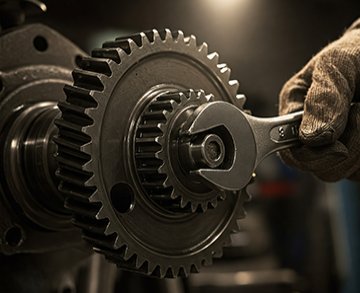Published: May 20, 2025 | Updated: October 22, 2025
Published: May 20, 2025 | Updated: October 22, 2025
How MRO Benefits Businesses and Improves Reliability
 In this article, we'll discuss how MRO benefits businesses. MRO stands for Maintenance, Repairs, and Operations. Read on for the following topics.
In this article, we'll discuss how MRO benefits businesses. MRO stands for Maintenance, Repairs, and Operations. Read on for the following topics.
⮚ The Importance of MRO for Business Performance.
⮚ Core Objects of MRO Programs.
⮚ How MRO Supports Supply Chain Management.
⮚ Types of MRO Services and Strategies.
⮚ Key Roles That Drive Successful MRO.
⮚ Enhancing MRO Efficiency with a CMMS.
MRO encompasses the processes, activities, and resources necessary to keep equipment, facilities, and infrastructure in optimal working condition. In essence, MRO ensures uninterrupted production, minimizes downtime, and extends asset lifespan.
The Importance of MRO for Business Performance
By its very definition above, you can see the importance and how it benefits businesses. It keeps the smooth functioning of assembly lines, machines, and tooling. This has a direct impact on output and product quality.
For instance, the aerospace industry relies heavily on MRO for aircraft maintenance, overhaul, and repair. They prioritize safety and operational efficiency.
Energy sector operations, from power generation to oil and gas extraction, depend on MRO to maintain critical infrastructure and prevent disruptions.
Even in the healthcare sector, MRO helps with the functionality of medical equipment, building systems, and patient care facilities.
Core Objects of MRO Programs
The goal of making for reliable and longer-lasting equipment relies on the following key factors.
Maximize Equipment Uptime
Unplanned equipment failures can lead to substantial production losses, decreased revenue, and increased costs. Preventive maintenance, predictive analytics, and condition monitoring minimize downtime.
By implementing regular inspections, lubrication, and component replacements, organizations can proactively address potential issues before they escalate into costly breakdowns.
Enhance Operational Efficiency
Streamlined maintenance processes, efficient resource allocation, and the elimination of waste contribute to improved productivity. By reducing maintenance-related bottlenecks and delays, organizations can increase throughput, meet customer demands, and improve overall performance.
Improve Product Quality
Companies want consistent product quality to stay competitive. MRO activities, such as calibration and equipment adjustments, help ensure that production processes operate within specified parameters. These results in fewer defects and higher product quality.
Ensure Safety
Safety needs to stay at the top of the list for all industries. MRO contributes to a safe working environment by identifying and mitigating potential hazards. Regular inspections, equipment testing, and compliance with safety regulations help prevent accidents, injuries, and equipment damage.
Extend Asset Lifespan
For reliability and to save expenses, you need the assets to last as long as possible. Proactive maintenance and timely repairs can significantly extend the lifespan of equipment and infrastructure.
Minimize Costs
Effective MRO practices can help control maintenance expenses. You schedule regular cycles of preventive maintenance (PM). You purchase only the amounts of stock you'll need.
With proper implementation of these practices, you'll see technician efficiency improve. Fewer unplanned downtime incidents mean reduced emergency expenses.
How MRO Supports Supply Chain Management
How does MRO benefit business? In part, by benefiting supply chain management. A well-managed supply chain ensures the timely availability of spare parts, consumables, and equipment. In that way, it keeps MRO operations efficient.
Conversely, MRO requirements influence supply chain planning and inventory management. Effective collaboration between MRO and supply chain teams ensures timely procurement, logistics, and inventory levels.
Types of MRO Services and Strategies
You can categorize MRO activities by their reactive or proactive nature:
Corrective Maintenance
This involves addressing equipment failures or breakdowns after they occur. While you can't eliminate unplanned downtime, you do your best. Corrective measures may involve extra expenses and disruptions.
However, you can minimize these with the proper foresight. Skilled workers, clearly defined procedures, and adequate inventory help reduce the intensity of the issue.
For a more detailed discussion on this, visit Camcode.
This proactive approach involves scheduled inspections, cleaning, and adjustments to prevent equipment failures. You want to identify and address potential issues before they escalate.
As stated before, PMs help extend equipment life, improve reliability, and reduce unplanned downtime.
Predictive Maintenance (PdM)
PMs benefit. PdMs give you a bonus. Sensors, analytics, and condition monitoring help you to predict equipment failures. In this method, you have a different type of step to stave off serious problems.
Overhaul
This involves more complex activities since you may need to completely disassemble, inspect, repair, and reassemble the machine.
An overhaul is a comprehensive restoration of equipment to its original condition. It typically involves a complete disassembly, inspection, repair, and reassembly of the equipment. You often conduct overhauls on critical equipment with long service lives.
Benefits of this type include identifying underlying problems. You also have the advantage of replacing parts rather than the entire asset. However, stay aware of the downtime and the potential for further issues.
For more discussion on this "extraordinary" repair, see Investopedia.
Calibration
Calibration ensures that equipment operates within specified tolerances. It involves adjusting equipment settings to meet predefined standards and is crucial for maintaining product quality and compliance with regulations.
Key Roles That Drive Successful MRO
Successful MRO operations require a diverse team of professionals with specialized skills.
- Maintenance Technicians. These frontline personnel perform hands-on maintenance and repair tasks. They possess technical expertise and are responsible for equipment troubleshooting, component replacement, and preventive maintenance activities.
- Maintenance Planners. These individuals develop and schedule maintenance activities, allocate resources, and optimize maintenance workflows. They work closely with maintenance technicians and other stakeholders to ensure efficient and effective maintenance operations.
- Maintenance Supervisors. Maintenance supervisors oversee maintenance teams, monitor performance, and ensure compliance with safety and quality standards.
- Reliability Engineers. These engineers focus on improving equipment reliability and reducing failures. They analyze equipment performance data, identify failure modes, and implement reliability improvement initiatives.
- Inventory Managers. Responsible for managing MRO spare parts and consumables.
- Procurement Specialists. These professionals source MRO materials, components, and services from suppliers. They negotiate contracts, manage supplier relationships, and ensure timely delivery of required items.
Of course, you may have one person take on a combination of these roles. For instance, you may have a supervisor both plan and schedule work orders.
Discover how streamlined maintenance processes can elevate production. Learn more.
 Enhancing MRO Efficiency with a CMMS
Enhancing MRO Efficiency with a CMMS
How does MRO benefit business? In part by using CMMS software. This acts as a central database for all maintenance activity. Let's briefly highlight some of the areas where a CMMS cuts to the heart of MRO and intricately involves itself with the entire process.
Work Order Management- Efficiently create, assign, and track work orders, improving communication and accountability.
Inventory Control - Monitor spare parts levels, optimize inventory levels, and reduce stockouts.
Preventive Maintenance Scheduling - Plan and schedule preventive maintenance tasks based on equipment usage and condition. Use a CMMS calendar for scheduling work orders and for easy viewing of upcoming jobs.
Asset Management - Track equipment history, maintenance records, and performance metrics. These help shape your PM program.
Data Analysis - Generate reports and key performance indicators (KPIs) to identify trends, measure performance, and make adjustments for improvement.
Mobile Access - Enable maintenance technicians to access information and update work orders in the field. What a boon to improving responsiveness and efficiency.
MRO: The Right Path for Your Maintenance Operations
From the above, you can see how MRO benefits businesses. It keeps assets reliable and pushes replacement time further out.
It emphasizes a proactive mindset rather than a reactive one. By not tending to assets until after they fail, you risk more expense and safety issues.
Preventive/predictive measurements seek to solve issues before they elevate to serious matters. Regular cycles of PMs and tracking of equipment readings will give you a better oversight of the performance of your assets.
When you have a CMS automating a lot of this data, you have better MRO organization. For the best in CMMS software, call 800-922-4336.
Schedule a free demonstration on how MAPCON enhances your MRO program.
FAQs
What is MRO and why is it important for businesses?
MRO, or Maintenance, Repairs, and Operations, ensures equipment, facilities, and systems stay in top condition to reduce downtime and boost reliability.
How does effective MRO improve business performance?
By preventing failures, improving safety, and keeping production lines running smoothly, MRO directly enhances productivity and product quality.
What are the main types of MRO strategies companies use?
Common MRO strategies include corrective, preventive, predictive, overhaul, and calibration practices tailored to business needs.
How does a CMMS improve MRO efficiency?
A CMMS like Mapcon centralizes maintenance data, automates scheduling, manages work orders, and tracks assets to streamline MRO processes.
What roles are essential for a successful MRO program?
Key roles include maintenance technicians, planners, supervisors, reliability engineers, and inventory or procurement specialists.
How does MRO help reduce operational costs?
Through preventive maintenance, inventory control, and reduced downtime, MRO programs minimize costly repairs and improve resource utilization.
MAPCON CMMS software empowers you to plan and execute PM tasks flawlessly, thanks to its wealth of features and customizable options. Want to see it for yourself? Click the button below to get your FREE 30-day trial of MAPCON!
Try It FREE!